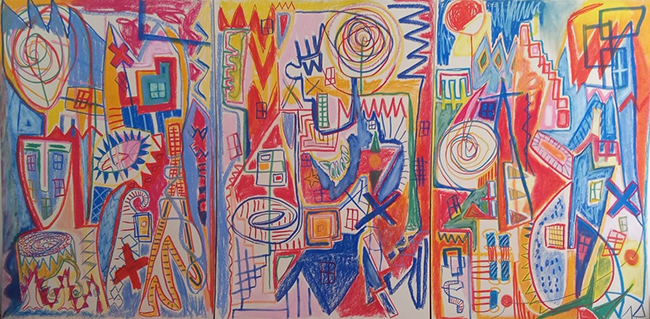Bruno Verdet’s path to painting was anything but conventional. After dedicating a decade to drama, Verdet immersed himself in the Grotowski method, a rigorous approach to acting that seeks to strip away the inessential. This focus on the essence of performance shaped his later transition to visual arts. A pivotal moment came when Verdet encountered the works of Joan Mitchell, Sam Francis, and Shirley Jaffe at the Galerie Jean Fournier in Paris. The experience introduced him to a vibrant intersection of Impressionism, Abstract Expressionism, and the influence of Matisse. It sparked a desire to translate emotion and movement into painted form.

Verdet’s work challenges the balance between form and chaos. Influenced by the words of Samuel Beckett—’The task of the artist is now to find a form that takes advantage of disorder’—Verdet delves into a space where recognizable shapes and chaotic disarray coexist. His paintings often appear like fragments of a disrupted reality. He likens this to the scattered building blocks of a child’s play, where the collapse of structure leaves behind a chaotic yet evocative residue.
His approach involves drawing simple, familiar shapes—those that traditionally help communicate or represent the world. However, Verdet disrupts their arrangement, deliberately altering their structure to void them of any singular meaning. The juxtaposition of these altered forms creates a sense of disordered harmony, a world that teeters between recognition and abstraction.
One of his notable works is the triptych titled ‘Saint Paul de Vence.’ This piece, made using dry pastel on a wood board and measuring 120 cm by 240 cm, was inspired by a visit to the Maeght Foundation in Saint Paul de Vence, France. The composition reflects Verdet’s signature method of blending form and formlessness, capturing the sense of a place not through literal representation but through abstract impressions that evoke the spirit of the environment.
Exhibiting mainly in Paris and other French cities, Verdet has carved out a unique space for his art. His work resonates with those drawn to the tension between structure and entropy. His pieces challenge viewers to interpret the familiar through a lens that embraces uncertainty and disintegration. Rather than offering clear narratives or symbolism, his paintings stand as open-ended questions about perception and reality.
Verdet’s commitment to exploring this fine line between order and chaos continues to drive his creative process. By rejecting conventional representation, he allows for a fluid interpretation that shifts depending on the viewer’s perspective. His use of color and shape serves as both a visual language and a commentary on the limits of meaning-making. In doing so, Verdet not only embraces the unpredictable but elevates it to an art form.
Bruno Verdet’s paintings invite reflection on how we perceive and interpret the world. They remind us that meaning is often fragmented, shaped not by a single image but by a collection of impressions that linger and evolve. In his work, the chaos-accepting form becomes a metaphor for human experience—unruly, scattered, yet undeniably compelling.
Bruno Verdet’s work will be on view from May 21 to June 3 at La Manutention in Avignon, France. For more, follow the artist on Instagram: @brunoverdetpeintures.

